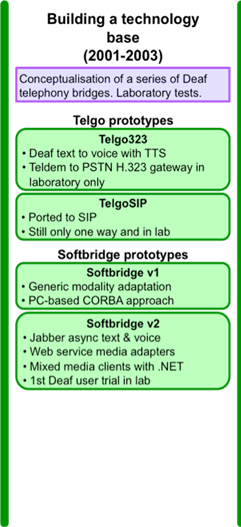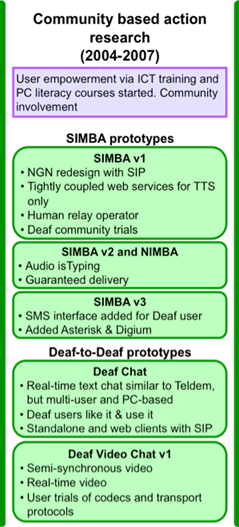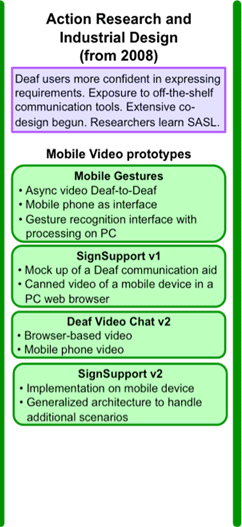11.3: Deaf Telephony: Community-Based Co-Design
Edwin Blake, William Tucker, Meryl Glaser and Adinda Freudenthal
Context
The Deaf Telephony project set out to assist South African Deaf people to communicate with each other, with hearing people and with public services. The team currently comprises researchers from the University of Cape Town (UCT), the University of the Western Cape (UWC), the Technical University of Delft (TU Delft) and the Deaf Community of Cape Town (DCCT-an NGO). This team has been working for many years with a Deaf community that has been disadvantaged due to both poverty and deafness. The story of this wide-ranging design has been one of continual fertile (and on occasion frustrating) co-design with this community. The team’s long-term involvement has meant they have transformed aspects of the community and that they have themselves been changed in what they view as important, and in how they approach design.
Deaf users in this community started out knowing essentially nothing about computers. Their preferred language is South African Sign Language (SASL) and this use of SASL is a proud sign of their identity as a people. Many are also illiterate or semi-literate. There are a large number of Deaf people using SASL; in fact there are more than some of the smaller official languages. Since the advent of democracy in South Africa in 1994 there has been an increasing empowerment of Deaf people. SASL is accepted as a distinct language in its own right. Deaf people encounter many problems with communication. Currently communications technology does not support sign language.
Method
In this case study we present an overview of the action research and design cycles over a period of ten years (2002-2011) during which both technological solutions and methodology were developed. Together with the Deaf community we have, over the years, evolved a way to collaborate for mutual benefit. Action research gradually moved from prototypes for research towards interventions that are used daily at the Deaf community centre. Our case study shares these learning experiences about the changing action research methodology.
The eventual method shares aspects of community-based co-design and action research. This methodology is a way of exploring a design space in a way that alleviates the restrictions of the designer’s own viewpoint and bias. In a cyclical fashion the designers develop according to their skills and learning and according to the users’ expressed requirements and their learning. The researchers and the users end up being the design team.
The Development of Community-based Co-design
The current combined approach, fusing action research, industrial design approaches, education and other societal measures was named ‘Community-based Co-design’. An initial validation of its feasibility was a joint review meeting of research and members of the Deaf community held in 2010. We evaluated the list of projects presented below and found directions for next steps.
The intention of the meeting was to launch the next phase as equal partners. It was clear that for the Deaf community the concerns were frequently of a more immediate nature (for example, an expansion of training in literacy and ICT, which is now emphasized in the forthcoming phase). The researchers would still lead action research measures which aimed at technology delivery in a more distant time but directions would be shaping jointly.
A discussion about how to approach and influence government policy was debated.A tentative outcome was that the most effective method of influencing policy would be to empower Deaf people to communicate their own requirements in interactions with government.Providing communication tools would be a significant aspect of empowerment.
Future Directions
The joint review meeting mentioned above set our agenda for the coming three years, in terms of approach, of roles and in specifying directions.
Our work is driven by the need for Universal Access for communication. From our earlier experiences we now believe that besides practical (technological) solutions and education, it is also imperative is to drive policy implementation. The South African framework of legislation comprises excellent policy on access. South Africa respects the right to be helped by an interpreter, and technology should ensure inclusive use of public amenities by all consumers. However, enacting policy is also about implementing practical solutions. In practice expensive and scarce human interpreters, which are currently the only option, are often not available. Technology (plus education) can be much cheaper than human labour, thereby providing promising solutions. Cost will remain an obstacle even at the more affordable rate offered by new technology. Deaf communication would be greatly aided by lower rates for mobile video streaming - and new government regulations can facilitate this.
Therefore, in the currently ongoing community-based co-design work we do not only target technology research and design, but we address three topics at the same time:
- Technical development
- Influencing government policy concerning Universal Access to communication
- Capacity Building -- ICT training
This long-term intimate involvement with the community has moved us from an ethical position where the researchers are the ‘experts’ and ‘active agents’ obliged to deal ethically with ‘subjects’ or ‘users’ to one where the major ethical consideration is one of reciprocity between equal partners. A long collaboration and mutual trust is needed to learn to collaborate like this.
 |
 |
 |
An overview of the action research cycles. Click on the cycle to view more detail.
The Case Study
The diagram highlights the various stages of our research project and lists the various prototypes that formed nodes in a design trajectory. The cyclical methodology of honing in on an effective implementation can be seen.
The Deaf telephony prototypes are grouped according to our basic methodological stance and then along several architectural themes.
The initial project aims were informed by outcomes from Teldem trials conducted by Glaser with a local Deaf community (Glaser, 2000). The methodology here was the user-centred design within an agile software engineering approach.The Telgo prototypes bridged a Teldem text terminal to a voice device on the Public Switched Telephone Network (PSTN) with Text-To-Speech (TTS). The Softbridge prototypes provided fully automated Deaf-to-hearing bridging between text and speech using Instant Messaging.
Based on user interaction we moved towards a community-based approach where we met the community demands for greater empowerment with regard to technology. At the same time the system testing was done within the community at their centre. The SIMBA prototypes continued the theme of using Instant Messaging but opted for a human relay operator rather than Automatic Speech Recognition (ASR). The text chat prototypes provided synchronous text messaging, similar to the Teldem, but with Internet clients. The video chat prototypes explored asynchronous video messaging to support high quality sign language communication.
Finally we adopted a co-design methodology within the community from about 2008.This resulted in greater exploration of the user lives and lifestyles. Researchers and students all learnt South African Sign Language as part of their involvement with the community.
References
- Blake EH and Tucker WD (2004). Bridging communications across the digital divide. Proc. 3rd Workshop on Social Intelligence Design, (SID 2004), Enschede, Netherlands, 29-38.
- Campbell B, Rosenberg J, Schulzrinne H, Huitema C and Gurle D (2002). Session Initiation Protocol (SIP) extension for instant messaging. RFC 3428.
- DoC (1996). Telecommunications Act No. 103 of 1996. President's Office, Republic of South Africa, No. 1869.
- DoC (2001). Telecommunications Amendment Bill 65 of 2001. Minister of Communications, Republic of South Africa, No. 22630.
- DoC (2005). Draft Convergence Bill B9 of 2005. Government Gazette, Republic of South Africa, No. 27294.
- Fetterman DM (1998). Ethnography, Step by step, second edition, Applied Social Research Methods Series Vol 17, Sage Publications, Inc, Thousand Oaks, CA.
- FreudenthalA and Looijesteijn K (2008). Co-designing for special user groups in developing countries: the Deaf in South Africa. Position paper for: Building an International Community: Designing Interactive Systems (DIS) for the Developing World workshop, 22-24 Feb 2008, Cape Town, South Africa.
- Glaser M (2000). A field trial and evaluation of Telkom's Teldem terminal in a Deaf community in the Western Cape. Proc. South African Telecommunication Networks and Applications Conference, (SATNAC 2000), Stellenbosch, South Africa, (CD-ROM publication).
- Glaser M and Tucker WD (2001). Web-based telephony bridges for the Deaf. Proc. South African Telecommunications Networks & Applications Conference, (SATNAC 2001), Wild Coast Sun, South Africa, 672-677.
- Glaser M and Tucker WD (2004). Telecommunications bridging between Deaf and hearing users in South Africa. Proc. Conference and Workshop on Assistive Technologies for Vision and Hearing Impairment, (CVHI 2004), Granada, Spain, (CD-ROM publication).
- Glaser M, Tucker WD and Mashao D (2004). Preparation of Deaf end-users and the Softbridge for semi-automated relay trials. Proc. South African Telecommunications Networks & Applications Conference, (SATNAC 2004), Stellenbosch, South Africa, II-255-256.
- Glaser M, Young P and Porteous L (2005). An information and communication technology (ICT) needs analysis and training programme for Deaf people. Proc. 20th International Congress on the Education of the Deaf, (iced 2005), Maastricht, Netherlands, 231.
- Handley M, Schulzrinne H, Schooler E and Rosenberg J (1999). SIP: Session initiation protocol. RFC 2543.
- Hersh MA and Tucker WD (2005). Ethics and mono-disciplinarity: Positivism, informed consent and informed participation. Proc. 16th International Federation of Automatic Control World Congress, (IFAC), Prague, Czech Republic.
- Julius EP (2006). Guaranteed delivery of multi-modal semi-synchronous IP-based communication. Unpublished MSc, University of the Western Cape, Bellville, South Africa.
- Julius EP and Tucker WD (2005). Guaranteed delivery of semi-synchronous IP-based communication. Proc. South African Telecommunications Networks & Applications Conference, (SATNAC 2005), Drakensburg, South Africa, I-407-412.
- Lewis J, Tucker WD and Blake EH (2002). Softbridge: An architecture for building IP-based bridges over the digital divide. Proc. South African Telecommunications Networks & Applications Conference, (SATNAC 2002), Drakensburg, South Africa, 383-386.
- Lewis J, Tucker WD and Blake EH (2003). Softbridge: A multimodal instant messaging bridging system. Proc. South African Telecommunications Networks & Applications Conference, (SATNAC 2003), George, South Africa, I-235-240.
- Looijesteijn K (2009). The design of a deaf-to-hearing communication aid for South Africans, MSc thesis, TU Delft.
- Ma ZY and Tucker WD (2007). Asynchronous video telephony for the Deaf. Proc. South African Telecommunications Networks and Applications Conference, (SATNAC 2007), Mauritius, 134-139.
- Ma ZY and Tucker WD (2008). Adapting x264 to asynchronous video telephony for the Deaf. Proc. South African Telecommunications Networks and Applications Conference, (SATNAC 2008), Wild Coast Sun.
- Mattelmäki T and Battarbee K (2002). Empathy probes, Proceedings of PDC2002, Malmö, June, 23-25.
- Mutemwa M and Tucker WD (2010). A mobile Deaf-to-hearing communication aid for medical diagnosis. Proc. South African Telecommunications Networks & Applications Conference, (SATNAC 2010), Stellenbosch, South Africa, 379-384.
- Office of the Deputy President (1997) White Paper on an Integrated National Disability Strategy. Western Cape: Rustica Press.
- Penton J (2003). An empirical, in-depth investigation into service creation in H.323 version 4 networks. Unpublished MSc, Rhodes University, Grahamstown, South Africa.
- Penton J, Tucker WD and Glaser M (2002). Telgo323: An H.323 bridge for Deaf telephony. Proc. South African Telecommunications Networks & Applications Conference, (SATNAC 2002), Drakensberg, South Africa, 309-313.
- Sanders EBN (2001). Harnessing People’s creativity: Ideation and Expression through Visual Communication, in Focus Groups: Supporting Effective Product Development Langford J and McDonagh-Philip D (eds.),Taylor and Francis.
- Sleeswijk Visser F (2009). Bringing the everyday life of people into design. Doctoral thesis, TU Delft.
- Sun T (2005). Carrier-grade adaptation for an IP-Based multimodal application server: Moving the Softbridge into SLEE. Unpublished MSc, University of the Western Cape, Bellville, South Africa.
- Sun T and Tucker WD (2004). A Softbridge with carrier grade reliability using JAIN SLEE. Proc. South African Telecommunications Networks & Applications Conference, (SATNAC 2004), Stellenbosch, South Africa, II-251-252.
- Tucker WD (2003). Social amelioration of bridged communication delay. 8th European Conference of Computer-supported Cooperative Work, (ECSCW 2003 Doctoral Colloquium), Helsinki, Finland.
- Tucker WD (2004). Connecting bridges across the digital divide. Proc Human Factors in Computing Systems, (CHI '04), Vienna, Austria, 1039-1040.
- Tucker WD, Glaser M and Penton J (2002). A bridge for the problem of Deaf telephony. Science in Africa, June 2002, http://www.scienceinafrica.co.za/2002/june/deaf.htm.
- Tucker WD, Blake EH and Glaser M (2003a). Building bridges for Deaf telephony in South Africa: A community-centred approach. IFIP Working Group 9.4 Newsletter, 13(2), http://www.iimahd.ernet.in/egov/ifip/nov2003/nov2003.htm.
- Tucker WD, Blake EH and Marsden G (2004). Open user interconnect and quality of communication. Proc. South African Telecommunications Networks & Applications Conference, (SATNAC 2004), Stellenbosch, South Africa, II-261-262.
- Tucker WD, Glaser M and Lewis J (2003b). Softbridge in action: The first Deaf telephony pilot. Proc. South African Telecommunications Networks & Applications Conference, (SATNAC 2003), George, South Africa, II-293-294.
- Wang YY and Tucker WD (2009). Browser-based video communication for Deaf people. Proc. South African Telecommunications Networks and Applications Conference, (SATNAC 2009), Swaziland, 489-490.
- Wang YY and Tucker WD (2010). Browser-based sign language communication. Proc. South African Telecommunications Networks & Applications Conference, (SATNAC 2010), Stellenbosch, South Africa, 71-76.
- Wang YY (2011). Browser-based and mobile video communication alternatives for Deaf people. MSc thesis, University of the Western Cape, Bellville, South Africa.
- Zulu TAZ and Le Roux KF (2005). A preliminary investigation into Text-To-Speech (TTS) software in a semi-automated relay service for Deaf telephony. Unpublished Honours, University of Cape Town, Cape Town, South Africa.
